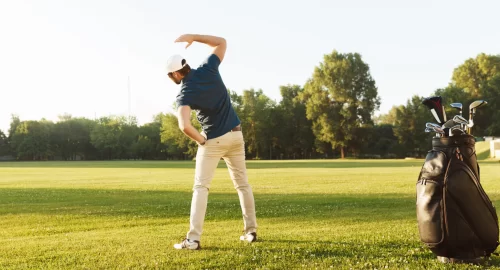
While slicing among golfers may be more common than the hook, the hook is still a shot that can cause major headaches and frustration. Hooks are not draws; they’re shots that go so far left (right-handed players) that you put yourself in trouble for the rest of the hole. These tips can help you make the right golf swing adjustments you need to fix a hook in golf.
Why Am I Hitting a Hook Shot?
The hook is caused when your clubface is closed at impact. However, the reason that clubface is closed and how it ended up there can vary from player to player. Here are a few reasons you are likely hitting a hook shot:
- Closed clubface at the top of the backswing: If the clubface is pointing to the sky at the top of the backswing, it will likely be closed at impact as well.
- Strong grip: A grip with the hands turned too far to the right (for right-handed players or left for left-handed players) can make it too easy to close the clubface down, leading to a hook.
- Inside-out swing path: Excessive inside-out swing path can cause a dramatic hook; combine that with a closed clubface and the shot doesn’t have a chance to go straight.
- Lack of shoulder turn: Not turning the shoulders properly and rotating the body through impact can result in a hook.
Hook With Irons vs. Driver
Most golfers struggle with the hook more when using their driver than they do in the irons, because the driver is longer and more difficult to control. Typically more advanced players struggle with the hook, and many tour professionals are aware of it and how it can sneak up in their game easily.
The ability to rotate the clubface of your golf club to a closed position is a good thing, but you’ll have to time that correctly to hit straight shots.
This video provides some great insight on how to fix your hook in golf under pressure.
4 Tips to Fix a Hook
Now that you have a better understanding of the hook’s causes, let’s get to work on fixing the issue.
Neutralize the Grip
The first place to start is in the hands. You can work through hook fixes all day with very little success because your grip is the problem. Neutralize the grip by turning your hands (right handed golfer) a bit more to the left.
This does not need to be a major exaggeration of the hand position, just a slight turn to see if it helps.
You don’t want to make the grip so weak that it encourages a slice. When adjusting the grip, make sure you change both the lead hand and trail hand position. When looking down at the ball, you should only see 2 to 3 knuckles of your left hand.
The V formed by the thumbs and forefingers will point between your neck and right shoulder.

Hit Shots From a Downhill Lie
Another great fix for a hook is to practice hitting shots on a downhill lie. While hitting these shots you’ll want to think about proper shoulder turn and following the slope on the finish of the swing. The concept of following the slope should minimize the chance of a hook.
When hitting shots from a downhill, you’ll also feel the clubface rotation and be able to control any excessive turning of the club.
Square the Clubface at the Top
Take some backswings and look at the clubface angle at the top of your backswing. You should not have the club pointing to the sky. Squaring the clubface could come down to the position of your lead wrist in the top of the backswing.
Then, shift your focus to the wrists and look at the wrist angle to see if it has too much bowing or flexion. If it does, the clubface will be closed. Instead, you want a flat lead wrist at the top of the backswing to ensure that you are able to square the clubface at impact.
Get the Club On the Right Path
If your hook is caused by an excessive inside out swing path, you’ll want to try and get it a little more neutral. One of the best ways to do this is with the use of alignment sticks. Place an alignment stick on the ground along your target line.
Take another alignment stick and place it parallel to the first one positioned just outside your golf ball. The stick is your guide to help you find a more neutral swing path. Golfers who hook typically exaggerate this inside-out move instead of using the shoulders to swing down the target line.
Bringing the club to impact from a slightly inside position is not necessarily a bad thing. It’s when this movement gets exaggerated that players struggle with the hook and get into golf swing problems.
Fix Your Hook for Good
These four tips will get you on your way to fixing your hook. Remember to start with the grip to make sure that you have the proper connection with the club. Then, start moving through the other fixes to get the clubface square and the club back on the proper plane.
When you fix the hook, you’ll feel more capable of swinging through the ball with full speed and not fearing the left side of the golf course. If you are still struggling with the hook, consider finding an instructor to look at your golf swing and give you some drills and actionable tips tailored to your needs, or check out a swing fix app for a more personalized experience.

